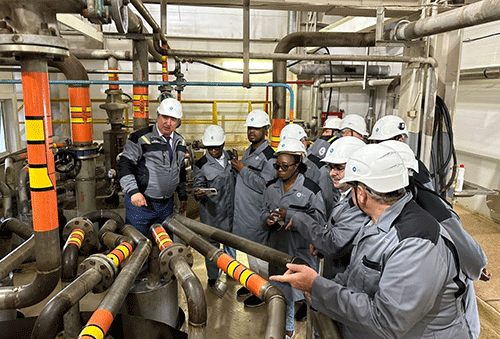Russia – The In Situ Leach (ISL) mining method can be defined as the extraction of uranium from the host sandstone by chemical solutions, and the recovery of uranium at the surface. Compared to conventional mining, ISL is recognised as having economic and environmental advantages when properly employed by knowledgeable specialists to extract uranium from suitable sandstone type deposits.
ISL involves extracting the ore mineral from the deposit by injecting a suitable leach solution into the ore zone below the water table, with minimal disturbance of the existing natural conditions of the earth’s subsurface and surface.
Dinis Ezhurov, director general of Dalur mine in Russia, said the method is economically profitable and environmentally-friendly, compared to the other mining methods. He noted that the ISL method continues to have a bigger share in global uranium production.
Ezhurov made these remarks in Russia during a recent familiarisation tour of the Dalur mine by journalists from Namibia and Tanzania. The tour was organised by Rosatom, Russia’s state-owned nuclear energy corporation. Dalur is one of the company’s modern, developing assets and the first uranium producer in Russia using ISL production technology.
Meanwhile, the World Nuclear Association stated that in 2019, a total of 31 435 tU (tonnes uranium) were produced by ISL, most of it in Kazakhstan, but with 3500 tU in Uzbekistan, and lesser amounts in the USA, Australia, China and Russia. This was a 57% share of the total global production volume of uranium, making it the most- used mining method that year.
By comparison, uranium produced from underground and open-pit mines that year came to 38% of the total uranium production worldwide.
Ezhurov stated that as per available data, no health hazards have been registered during almost 50 years of the ISL mining method implementation.
“The method remains the most preferred due to its advantages. In 2021, 51% of global total production was from the ILS method. According to projections, 60% of uranium will be recovered by the mentioned mining method,” he observed.
Fear of the unknown
Russian company Uranium One Group, exploring for the rare mineral in the Omaheke region, is keen to undertake measures to ensure it does not contaminate a valuable water aquifer in the area. In Namibia, environmentalists and farmers are vehemently opposing Uranium One’s operations and exploration plans. These measures include monitoring wells at the discovered ore body, wells along the water source, and wells where communities actually access the water. Uranium One would then have to constantly monitor all these wells, in conjunction with an independent third party, to ensure the water is not contaminated.
When asked how Namibia can preserve its water aquifer and save it from chemical contamination and from spreading these contaminants along the aquifer, the director general said the method is closely monitored with monitoring boreholes and legislations.
“There is complete control from the start. Besides the monitoring wells, the method is also monitored by independent authorities with certified State labs. Furthermore, there are community members who had fears at first, but now they are residing about 500 metres from our operations with their crops,” said Ezhurov.
At the same occasion, Andrey Ivanov, who is the head of public relations at the Dalur mine, said upon the introduction of the method in Russia, they also experienced fears from farmers, just like in Namibia.
“It’s not different here. When the ISL method was introduced, the community also raised their concerns. Politicians by that time likewise instilled fear into people to gain votes. But later, farmers came to their senses, and now they are enjoying their farming with no interruptions from us as anticipated. We kept transparency at the highest level with people, especially on the radiation numbers, with community campaigns explaining what the numbers mean,” stated Ivanov.
Uranium One’s views are in stark contrast to a firm stance taken late last year by agriculture, water and land reform minister Calle Schlettwein, who said no uranium mining would be approved in order to safeguard the quality of scarce groundwater resources in the vicinity.
Schlettwein was adamant at the time that Uranium One must present scientific data to show no contamination of underground water would occur if the company is granted permits to continue with uranium exploration.
Headspring Investment, the local subsidiary of Uranium One, approached the High Court on this matter as an applicant,
where 39 parties are cited as respondents. The relief sought by Uranium One is to review and set aside the decision by the agriculture and water ministry to refuse to issue an exploration drilling permit.
Uranium One spokesperson Riaan van Rooyen said in a statement that the company already started to invest heavily in the upliftment of the Leonardville community. He noted that the company had spent over N$3.8 million on corporate social responsibility (CSR), and has invested N$850 million thus far on exploration processes. Van Rooyen added that the contribution to the government on taxes and royalties will be immense.
Patrobas Ngarizemo, a farmer who resides about 30km south of Leonardville, last month said he has no doubt about the project. “This company did not come straight from Russia to the Omaheke region; they passed through the government.
I stay around these people, and these people are dying of hunger. The reality here is tough. Rejecting the project from far is fine, but people here are of the conclusion that let the water contamination (if there will be any) kill us; there is no difference with today’s hunger,” observed the emotional farmer.


